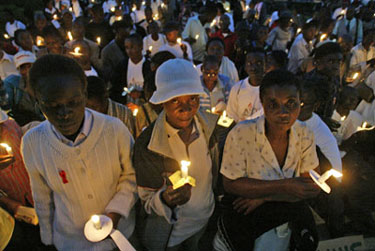By George Curry
-Guest Columnist-
- Black groups band together to fight AIDS (FCN, 08-29-2006)

For the moment, set aside the talk about microbicides, pre-exposure prophylaxis, post-exposure prophylaxis, combination therapy and HAART (Highly Active Antiretroviral Treatment). Throw out all of the acronyms associated with the deadly alphabets of HIV and AIDS. Once one moves pass all medical jargon, the realization sets in that, regardless of the scientific progress that has been made and is yet to be made, many of the obstacles associated with preventing HIV and halting the spread of AIDS are everyday issues that must be addressed as urgently as the scientific quest to develop an effective vaccine.
First, there is the simple issue of not having enough healthcare workers.
The World Health Organization (WHO) estimates that more than four million global health workers, including doctors, nurses and midwives, are needed to deal with public health threats. There is a chronic shortage in sub-Saharan Africa.
“With 11 percent of the world’s population and 24 percent of the global burden of disease, the region has only three percent of the world’s health workers commanding less than one percent of world health expenditure,” according to a recent WHO publication, entitled, “Taking Stock: Health Worker Shortages and the Response to AIDS.”
It continues, “By contrast, the WHO Region of the Americas, with 10 percent of the global burden of the disease, has 37 percent of the world’s health workers and spends more than 50 percent of the world’s health financing.”
Health workers, particularly those working in Third World countries, also say that while HIV/AIDS is an important issue, it must be placed in a larger healthcare context.
“Unless we start looking at the factors, the root causes that drive health disparities–in other words, why some of us get sick and some of us don’t–broadly within our communities, we will be always treating one illness, while the ‘patient’ dies of another,” Gregg Gonsalves, an AIDS activist from Cape Town, South Africa, told the delegates to this year’s international AIDS convention held in Toronto, Canada.
“It’s no coincidence that these multiple epidemics exist among marginalized communities across the globe–among the poor, women, drug users, sex workers, gay men, prisoners, migrants. The social, economic and political policies that create this marginalization in the first place also push us into the path of oncoming epidemics,” he said. “Yet, we continue to place our hopes in prevention programs that narrowly construct risk around individual behavior or in some new technology that will save us.”
The United Nations General Assembly’s Political Declaration on HIV/AIDS declared that there is a direct link between AIDS and agriculture and nutrition. He called for “sufficient, safe and nutritious food” as part of an overall HIV/AIDS strategy.
In many impoverished counties, the cost of life-saving drugs is prohibitive. Sen. Patrick Leahy (D-Vt.) has introduced a bill that would allow U.S. generic drug firms to manufacture low-cost generic versions of patented medicines for export to needy nations if a voluntary agreement cannot be reached between the patent-owning and generic manufacturer.
Pharmaceutical companies are not the only culprits. In many countries, the government is responsible for thousands of deaths. Human Rights Watch, for example, noted that in Zimbabwe, “Three thousand people die each week due to governmental policies that create formidable obstacles to accessing life-saving treatment.”
It’s also tough, if not impossible, to get around many of the customs in male-oriented societies. President George Bush has insisted that at least one-third of U.S. funds to fight AIDS must go to the ABC program–“Abstain, Be faithful, use Condoms.” In a speech to the convention, Bill Gates noted, “Abstinence is often not an option for poor women and girls who have no choice but to marry at an early age. Being faithful will not protect a woman whose partner is not faithful. And using condoms is not a decision that a woman can make by herself; it depends on a man.”
There are also the issues of stigma and discrimination. And the church, as the foremost defender of moral and social norms, has been complicit in condemning those afflicted with AIDS.
“We raise our voices to call for an end to silence about this disease–the silence of stigma, the silence of denial, the silence of fear,” declares a 2002 statement from Anglican Primates on AIDS. “We confess that the Church herself has been complicit in this silence. When we have raised our voices in the past, it has been too often a voice of condemnation. We now wish to make it clear that HIV/AIDS is not a punishment from God. Our Christian faith compels us to accept that all persons, including those who are living with HIV/AIDS, are made in the image of God and are children of God.”
(George Curry is editor-in-chief of the NNPA News Service and BlackPressUSA.com. He may be contacted via his website at www.georgecurry.com.)












